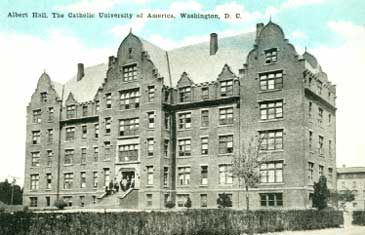Review: Undergraduate Days 1904-1908: The Catholic University of America
by Frank Kuntz
CUA Press, 1958
I own most of the extant histories of Catholic U. These are in fact histories of the administration and faculty and say little or nothing about student and town life.
To be sure, CU, 100 years younger than Georgetown and never an institution for adolescents, does not have a colorful legacy of Rotten Cabbage Rebellions and students draggng cannons up the stairs to blow masters' doors open. However, one can't look at the ancient stone walls and woodwork of MacMahon and Caldwell Halls without wondering about the lives, unrecorded and forgotten, lived around them.
That's what makes Frank Kuntz' book so delightful. It's the story of him and his classmates at CU 100 years ago. They were the first undergraduates to be admitted to CU, taken in because the university, set up for Masters and Doctorates, was struggling financially.
Kuntz' CU is on a Michigan Ave. pitch dark without streetlights and a right-of-way for defective trolley tracks and a temporary railroad spur feeding the construction of MacMillan Reservoir. Lectures are interrupted by two locos pulling cars back and forth to the main line across which is the Brooks' coalyard. Priests from all over Brookland are summoned to the terrible Terra Cotta (Fort Totten) train wreck in 1906.
The Dominican House of Studies goes up quickly in 1905. President Theodore Roosevelt, riding by on horseback, stops in to admire the statue of Leo XIII in MacMahon. Behind MacMahon, where the big parking lot now is, was a ravine where a 30-foot chunk of MacMahon roof was deposited in a storm. In that wreckage lived a ragged hermit who knelt outside in prayer during Mass and passed every charity left for him on to a nearby orphanage.
"Lights Out" meant lights out. Electricity, supplied by a dynamo in MacMahon basement, was turned off at bedtime. An anecdote about a crap game hosted by CU staff behind the long-gone Albert Hall:
"The crap players were a couple of our waiters and several of their friends who had no right to be on the campus at all....there was a human skeleton which we rubbed all over with wet phosphorous....We waited until the crap game was at its height of excitement and gently lowered the skeleton right into the middle of it. The crap shooters darted in all directions. Two went screaming against the building."
"It was not at all unusual for people to come sightseeing to the University. Most of them wanted to see the $50,000 "chair" the Knights of Columbus had donated to the Department of History. We used to tell them that the rector was sitting in it right then and we were not permitted to disturb him."
When Kuntz graduated in 1908, things looked pretty bleak. The administration--those guys mentioned in the other histories--was shutting down the law school and electrical engineering depts--foolishly says the space between the lines-- to save money.
"This will all blow over," faculty members assured Kuntz, "Wait until the new pope, Pius X, becames aware of the situation. The University will go on as before."
 |
| Torn down in 1970, student dorm Albert Hall was just inside the Catholic U. front gate, itself no longer extant. Its Dutch Colonial style is one of endless styles tried by CU over the decades. In the early 1900s, one student boarder turned out to be a criminal in possession of a handgun. Frank Kuntz and classmates, with the approval of the administration, sent him packing with a baseball bat tattoo. |
Copyright © 1997, 2004 by Neal J. Conway. All rights reserved.